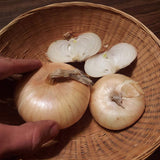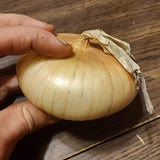Yellow Cipollini Onion
Allium cepa
What a delicious onion! I've chatted with many a farmer and this onion type is often mentioned as their FAVORITE! Yellow Cipollini has the distinctive flat shape with excellent flavor we all love. This onion seed in particular was grown out by Cultivating The Commons in response to the pandemic seed shortages. The farm Clint worked for mentioned there being seed shortages and especially the beloved cipollini. Low and behold that winter, Clint noticed their fridge was loaded with a large box of unsold cipollinis and had them planted out the next summer for seed production, demonstrating what Farmer/Seed Grower relationships could look like! This onion was selected by the farmer against early bolting (nearly 5-8% would bolt), for large storability and for nice shape. Next generations will be tested for flavor, stay tuned! (Description by our grower friends at Cultivating the Commons).
Days to maturity: 120
Seeds per pack: 250
Germination rate: 66% on 01/24/2025 (below standard)
Planting / harvesting notes
Onions require full sun and well drained soil. Add plenty of compost or a raised bed for heavy soils. Direct sow in as soon as the soil can be worked in early spring (April/May in many places), and spread seeds in a 2 inch wide band, about 2 seeds/inch and 1/4 inch deep with rows 12–18 inches apart. Thin seedlings to about 2 inches apart (or 3-4 inches apart for larger onions).
Alternatively, in shorter season areas, sow seeds indoors in late February to mid-March. Spread seeds 1/2 inch apart and cover 1/4 inch. Transplant to the garden 4 inches apart. Harvest when necks become soft and tops flop over. Cure in the sun for 2-7 days, and finish curing somewhere more protected from the elements.
Seed keeping notes
Onions are biennials, and go to flower and seed in their second year only. Separate onions of different varieties by 800 feet to 1/2 a mile. To preserve the genetic diversity of your onion population, save seeds from at least 5 plants, but 20-50 plants is even better. Allow the flower heads to dry on the plant and the seeds to develop. Harvest the seed head when the seeds just start to fall on their own and place them upside-down in a paper bag. Many seeds will fall in the process of collecting the seed heads this way. Rough up the seed heads to remove the seeds and sift out the seeds from the chaff with a strainer or screen. Winnow gently with your breath, the wind, or a fan, and store seeds in a well-labeled, air-tight, screw top jar in a cool, dark place such as a basement or closet.









